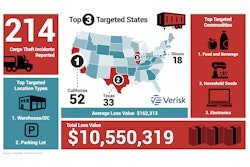
When it comes to health, the most basic things doctors will tell you are to improve your diet and to exercise. If you want to live a healthy life, diet and exercise are the first places to start working.
For many, 30 minutes of walking or jogging several times a week can make a huge difference, but given the trucking lifestyle, regularly scheduled exercise can be difficult to pull off, making a healthy diet even more important.
Eating healthy is not always a simple matter, either, with deadlines rushing drivers and good grocery stores sometimes hard to come by. Fortunately, there are some basic rules to healthy eating that everyone can follow with a little effort, and it starts with portioning out your food and eating regularly.
Pam Whitfield, a registered dietician and co-author with Don Jacobson of the book “Roadcookin’: A long-haul driver’s guide to healthy eating,” says regular meals are an important part of healthy eating.
“I would strongly encourage regular meals. I mean eating every four to five hours. It’s much better to eat four to six small meals instead of one large meal,” said Whitfield.
Regular meals help prevent low blood sugar, she adds, and eating regularly can help control hunger. If you’re facing time constraints — for instance, difficulty getting up early to do things like cook breakfast — plan early how to get meals in throughout each day.
What you eat and how much you eat are just as important as eating regularly, of course. According to the USDA’s new MyPlate initiative, which replaced the traditional food pyramid many grew up studying, you should try to make half of each meal fruits and vegetables. If you have a refrigerator in your cab, it’s a good idea to stock it with a few items of fresh produce when you can. MyPlate also has suggestions on how much food you should eat in a day — 5 to 6.5 ounces of meat, for instance.
That amount may seem small to some. An 8-ounce steak or hamburger can be eaten in just one meal out at a restaurant, which more than covers your entire daily portion. That’s why it’s important to start weaning yourself off big meals and to start lowering your portion sizes.
“Eat slowly, try to eat less and drink plenty of water,” Whitfield says.“Include a fruit, vegetable serving, a starch, but not too much, and a lean meat. On the protein side, I would always go lean. With starches, we want to find fiber.”
Read the labels on what you’re buying to find dietary content, she adds, or ask for the nutritional facts at restaurants.
“The main three things to include is more fiber, less salt and less saturated fat,” Whitfield said.
QUICK FACTS
• Go online to https://www.choosemyplate.gov/ for more information and tips on healthy eating.
• Be careful about what easy, long-lasting foods you get. Things like dried fruit may seem like a healthy choice, but many have sugar added and can be high in calories.
• If you’re hungry, don’t ignore it. Try eating a little something just to get you by, like a yogurt or a protein bar.
• Your brain takes about 10 to 15 minutes to catch up to what’s happening in your stomach. If you eat too quickly, you could make yourself full before your brain tells you you’re no longer hungry. It’s important to eat slowly to prevent overeating in a meal.
• Look for lean meats (like chicken breast instead of wings and legs) and whole grain breads and pastas. A good substitute for a cheeseburger is a grilled chicken breast on wheat bread. Add some mustard, lettuce and a tomato slice for a delicious, healthy alternative.
• Plan your meals ahead of time. Be sure to get in at least three meals during the day, and don’t go easy on the fruits and vegetables. Have healthy snacks nearby to help calm any hunger pangs you may experience.








